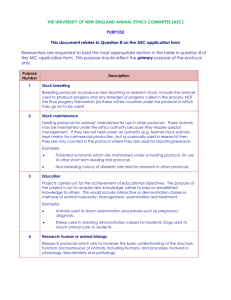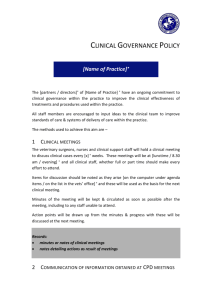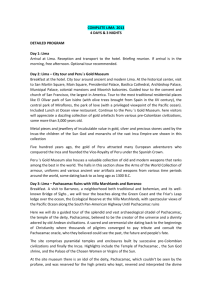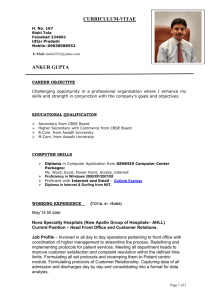Notarial Protocols of the sixteenth to twentieth centuries
advertisement
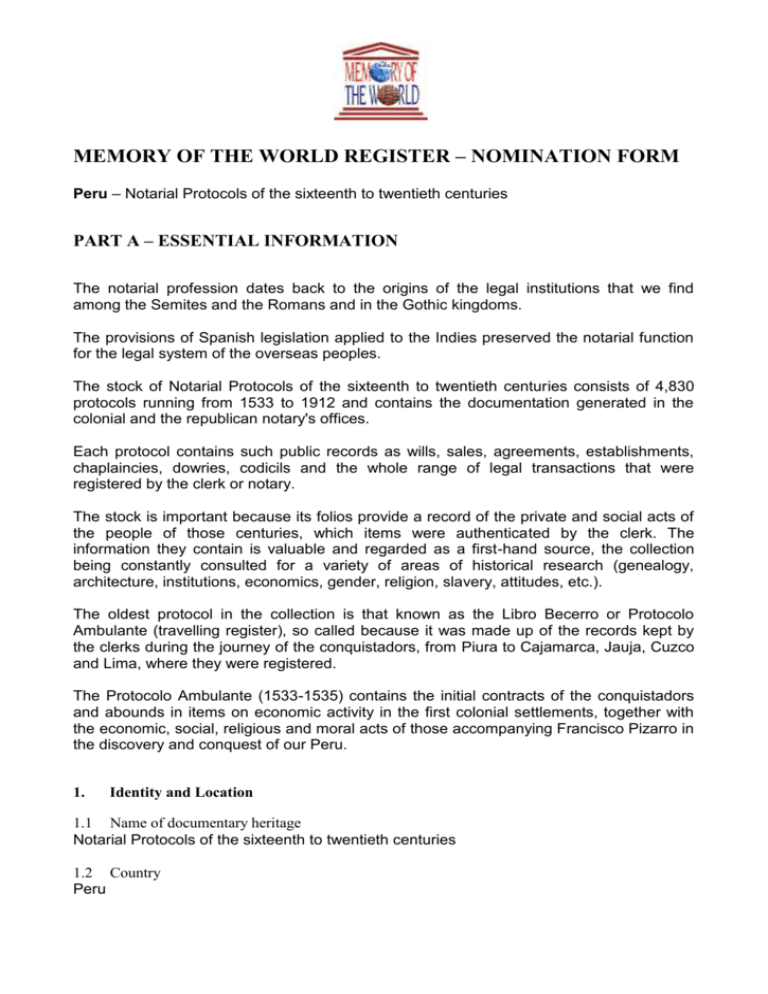
MEMORY OF THE WORLD REGISTER – NOMINATION FORM Peru – Notarial Protocols of the sixteenth to twentieth centuries PART A – ESSENTIAL INFORMATION The notarial profession dates back to the origins of the legal institutions that we find among the Semites and the Romans and in the Gothic kingdoms. The provisions of Spanish legislation applied to the Indies preserved the notarial function for the legal system of the overseas peoples. The stock of Notarial Protocols of the sixteenth to twentieth centuries consists of 4,830 protocols running from 1533 to 1912 and contains the documentation generated in the colonial and the republican notary's offices. Each protocol contains such public records as wills, sales, agreements, establishments, chaplaincies, dowries, codicils and the whole range of legal transactions that were registered by the clerk or notary. The stock is important because its folios provide a record of the private and social acts of the people of those centuries, which items were authenticated by the clerk. The information they contain is valuable and regarded as a first-hand source, the collection being constantly consulted for a variety of areas of historical research (genealogy, architecture, institutions, economics, gender, religion, slavery, attitudes, etc.). The oldest protocol in the collection is that known as the Libro Becerro or Protocolo Ambulante (travelling register), so called because it was made up of the records kept by the clerks during the journey of the conquistadors, from Piura to Cajamarca, Jauja, Cuzco and Lima, where they were registered. The Protocolo Ambulante (1533-1535) contains the initial contracts of the conquistadors and abounds in items on economic activity in the first colonial settlements, together with the economic, social, religious and moral acts of those accompanying Francisco Pizarro in the discovery and conquest of our Peru. 1. Identity and Location 1.1 Name of documentary heritage Notarial Protocols of the sixteenth to twentieth centuries 1.2 Country Peru 2 1.3 State, province or region City of Lima 1.4 Address Jr. Manuel Cuadros s/n Palacio de Justicia, Lima – Peru 1.5 Name of organization or institution (if appropriate) Archivo General de la Nación 2. Legal Information 2.1 Owner (name and contact details) Archivo General de la Nación Jr. Manuel Cuadros s/n Palacio de Justicia Tel.: 4275930 Fax: 4282829 E-mail: agnperu@terra.com.pe 2.2 Custodian (name and contact details) Archivo General de la Nación 2.3 Legal status ( if different from 2.1) (a) category of ownership (e.g. public, corporate or private) Public (b) details of legal and administrative provisions for the preservation of the documentary heritage Decree Law 19414, Law concerning the Defence, Preservation and Increase of the Documentary Heritage of the Nation (16 May 1972) Executive Resolution N° 001-82/AGN/DGAH, Operational Regulations of the Research Facility of the Archivo General de la Nación (1982) Law 24047, General Act for Protection of the Documentary Heritage of the Nation (3 January 1985) Law 25323 of the National Archives System (11 June 1991) Political Constitution of Peru, Article 21. (c) accessibility Accessible for research purposes (d) copyright status The documentation is kept by the Archivo General de la Nación and forms part of the Documentary Heritage of Peru. 2.4 Responsible administration The Colonial Archive Directorate, an organ of the National Historical Archive Directorate responsible for organizing, preserving, describing and making available the documentation produced in the colonial and republican periods, is in charge of the stock of Notarial Protocols of the sixteenth to twentieth centuries. 3 3. Identification 3.1 Description and inventory The stock of Notarial Protocols of the sixteenth to twentieth centuries is made up 4,830 protocols, running from 1533 to 1912, generated in the colonial and republican notary's offices under the responsibility of officials empowered to provide judicial and extrajudicial attestation. Each protocol contains such public records as sales, obligations, donations, wills, deposits, dowries, revocations, agreements, contracts, censuses and the whole range of legal acts of each century. Under an agreement with the Spanish Agency for International Cooperation, the Archivo General de la Nación is at present engaged in the "AGN Computerization Project", and one of the collections being described is that of Notarial Protocols, beginning with those of the sixteenth century. The protocols described will subsequently be digitized so that the service can be provided by means of computers, thereby ensuring preservation of the documents without denying the information. The Notarial Protocols are classified by century and listed in the alphabetical order of the surname of the clerk: - 3.2 Sixteenth-century protocols, 167 protocols (including the Protocolo Ambulante) Seventeenth-century protocols, 2,083 protocols Eighteenth-century protocols, 1,199 protocols Nineteenth-century protocols, 1,161 protocols Inca protocols of the sixteenth to nineteenth centuries, 220 protocols Descriptive instrument: Alphabetical index of clerks (type-written), Catalogue and microfilming of seventeenth-century notarial protocols (protocols 1 to 231). Bibliographic/Registration details Index of Notaries of Lima and Callao in the sixteenth to nineteenth centuries, by Horacio Urteaga, year 1928. Index of the "Libro Becerro de Escrituras" (register of records), by Guillermo Lohmann Villena, in Revista del Archivo Nacional del Perú, Volumes XIV, 1941; XV, 1942; XVI, 1943; and XVII, 1944. 3.3 Visual documentation, if appropriate (for example, photographs or a video of the documentary heritage) 3.4 History The name used to describe those performing the function was not always the same. They are thus variously termed Escribano Real (royal clerk), Escribano de Número (appeal court clerk), Secretario de Cámara (chamber secretary) and, in recent times, Notario (notary). This official, who was empowered to provide judicial and extrajudicial attestation, functioned right from the time of the first administrative acts when the conquistadors reached Peru. One of the expedition members arriving with Francisco Pizarro was Pedro Sánchez de la Hoz, who had been appointed “Escribano General” in the Kingdoms of Nueva Castilla and whom Francisco Pizarro had brought as secretary. 4 3.5 Bibliography: Please indicate up to three published sources describing the proposed documentary heritage. 3.6 Names, qualifications and contact details of up to three independent people or organizations with expert knowledge about the values and provenance of the documentary heritage RP. Padre Antonio San Cristóbal Sebastián Jirón Prolongación Lucanas 850 Lima 13 Tel.: 51-1-474-9271 Dr. Guillermo Lohmann Villena Calle Antero Aspíllaga 461 Lima 27 Tel.: 51-1-422-2607 Dr. Carlos Alfonso Villanueva Carbajal Avenida Prescott 460 Lima 27 Tel.: 51-1-471-8084 4. Management plan – see below Annex 1 Part of the stock of "Notarial Protocols of the sixteenth to twentieth centuries" is at present being processed under the "AGN Computerization Project" referred to in section 3.1 above. It should be noted that, once they have been described, damaged notarial protocols undergo restoration by specialist personnel. 5. Assessment against the Selection Criteria 5.1 Assessment of the documentary heritage against each criterion described in Annex 2. Criterion 1: Time Research on historical events in Peru's colonial and republican periods is able, with the Notarial Protocols, to rely on one of the most substantial sources for consultation. The documents that go to make up the Protocolo Ambulante were basically generated in Peru, but to gauge its geographical dimension we have to remember that, in that initial period of colonization, Peru was the central core of it. The zone of influence of the Government of Nueva Castilla, which was entrusted to Pizarro, extended from Panama, the starting point of the Conquest, along the coast of what are now the Republics of Colombia and Ecuador and in its development was projected over the present-day Bolivia, Rio de la Plata and Chile. Since the expeditions into those territories set out from Cuzco, the action of the people concerned and the unfolding of events were registered in the 5 notarial acts, which, though strictly speaking private law documents, reflect life and events, daily life and events of regional scope. 5.2 Contextual assessment including an assessment of the importance of a series of documents, the importance of a series of documents in a particular setting, and the assessment against other documentary heritage The holdings proposed by the AGN for inclusion in the "Memory of the World Register" include the "Protocolo Ambulante" or "Libro de Becerro", which contains the first public records kept by the Spanish when they undertook the conquest of the Inca Empire (1533-1535). The protocol of the conquistadors, with its close on 800 documents, covers a time span extending from the incursion into Cajamarca, the capture of the Inca sovereign, the insurrection of Mango Inga and the preliminary skirmishes of the first war between Pizarro and Almagro, therefore including the period when Cuzco was taken over and Lima founded; and preparations for Almagro's expedition to Chile. The wide range of matters covered throws light on: (a) economic aspects, with instruments recording the transmission of property (mounts, slaves, weaponry), company contracts under the most original of terms, imports of goods from Panama, the first consignments of precious metals sent to Spain, and service contracts. (b) demographic aspects, with the origins of the conquistadors and their assignments upon their return, and individual biographies covering all social classes from commanders, knights of the noble orders and officials to artisans and the tonsured. (c) cultural aspects since those documents reflect the first instances of use of the Spanish language in Peru, in addition to initial literati (Alonso Enríquez, etc.) and the standard of education. (d) military aspects, with the systems of recruitment of troops and authorization of men-atarms. (e) legal aspects, affording an outline of judicial usage and custom. To appreciate the importance of this corpus of documents, account has to be taken of the fact that it is unique material of guaranteed authenticity and profound significance because it concerns the roots of nationality upon insertion in European civilization. 5.3 An evaluation of the authenticity The notarial protocols preserved and made available by the Archivo General de la Nación are regarded as first-hand sources for historical research on account of their wealth of information and their authenticity. The fact is that public records were established before clerks who were public officials authorized to certify, in accordance with the laws, contracts and other extrajudicial acts and, on the strength of this, they were empowered to issue public deeds, authorize wills, open wills and safeguard the protocols in their possession. 6 6. Consultation 6.1 Details of consultation about the nomination with the: (a) Owner Archivo General de la Nación (b) Custodian Archivo General de la Nación 7. Nominator 7.1 Name Dr Aída Luz Mendoza Navarro 7.2 Relationship to documentary heritage Chief, Archivo General de la Nación 7.3 Contact person (if appropriate) 7.4 Contact details Dra. Aída Luz Mendoza Navarro Jefa del Archivo General de la Nación Jr. Manuel Cuadros s/n – Palacio de Justicia Apartado 3124 Lima 100 Peru 7.5 E-mail: agnperu@terra.com.pe Telephone: 51-1-4275930 1. Letter of Agreement between Francisco Pizarro, Governor and Captain General, and Juan Pérez de Vicuña for the administration of an estate. Lima, 12 December 1535. Protocolo Ambulante s/n Document N° 690. Francisco Pizarro, recognized by the Accord of Toledo as Governor and Bailiff Major of the said province of Peru, was the man who, together with Diego de Almagro and Hernando de Luque, directed the conquest of Peru and the founding of the first Spanish cities. 2. Letter of Obligation from Juan de Tardajos for 500 pesos in favour of Gerónimo de Loayza, Archbishop of Lima, 6 March 1573. f. 152v – 153v. Protocol N° 71. Juan Gutiérrez (1573). Gerónimo de Loayza, the first Archbishop of Lima, promoted the establishment of the Universidad Nacional Mayor of San Marcos and issued standards for the conversion to 7 Christianity of the indigenous inhabitants, holding two councils (1551 and 1567) to determine the doctrines to which that mission was to be subjected. 3. Retrocession Letter of Brother Martín de Porras with respect to an authorization granted in favour of Joan de Porras. Lima, 28 January 1636. f. 135 – 135v. Protocol N° 2000. Diego Jaramillo (1635-1636). Martín de Porras, a saint who worked miracles and displayed humility, charity and discipline. The Church canonized him, by papal bull of 29 October 1837, which proclaimed his beatification; and by bull of 6 May 1962, which sanctified him. 4. Letter of Obligation of Túpuc Amaru for 8,262 pesos in favour of Miguel Surco Montiel y Gómez. Lima, 3 January 1778. f. 505 – 505v. Protocol N° 963. Andrés de Sandoval (1777-1778). José Gabriel Condorcanqui, Túpac Amaru II, precursor of independence and directly descended from a daughter of the Inca Túpac Amaru; a Cuzco cacique and leader of the general uprising of the Indians that began on 4 November 1780 in Tungasuca, Cuzco. 5. Letter of Donation of a house and mill granted by Pedro Nolasco de Portillo to Micaela Villegas. Lima, 13 September 1781. f. 481 – 486v. Protocol N° 454. Gervasio de Figueroa (1780-1781). Micaela Villegas, known as "La Perricholi", was a Lima comedian and singer famed for her love affair with the Viceroy Manuel de Amat y Junyent.


